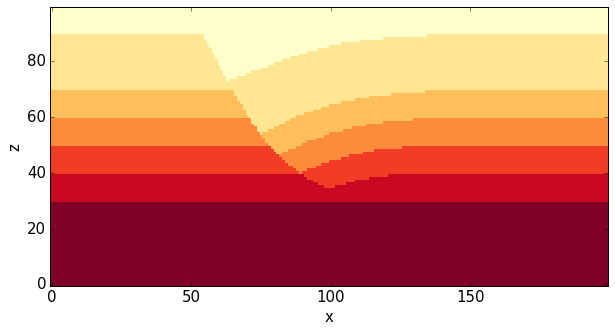Fault shapes¶
We are here briefly showing the possibility of Noddy to model more complex fault shapes than simple planar faults.
from matplotlib import rc_params
from IPython.core.display import HTML
css_file = 'pynoddy.css'
HTML(open(css_file, "r").read())
import sys, os
import matplotlib.pyplot as plt
# adjust some settings for matplotlib
from matplotlib import rcParams
# print rcParams
rcParams['font.size'] = 15
# determine path of repository to set paths corretly below
repo_path = os.path.realpath('../..')
import pynoddy.history
import pynoddy.experiment
import pynoddy.events
<module 'pynoddy.experiment' from '/Users/flow/git/pynoddy/pynoddy/experiment/__init__.pyc'>
%matplotlib inline
rcParams.update({'font.size': 20})
We will create a model with a listric fault from scratch. In addition to the previous parameters for creating a fault (see notebook 4-Create-model), we now change the fault “geometry” to “Curved” and add parameters defining the amplitude and radius of influence:
reload(pynoddy.history)
reload(pynoddy.events)
nm = pynoddy.history.NoddyHistory()
# add stratigraphy
strati_options = {'num_layers' : 8,
'layer_names' : ['layer 1', 'layer 2', 'layer 3', 'layer 4', 'layer 5', 'layer 6', 'layer 7', 'layer 8'],
'layer_thickness' : [1000, 500, 500, 500, 500, 500, 1000, 2000]}
nm.add_event('stratigraphy', strati_options )
# The following options define the fault geometry:
fault_options = {'name' : 'Fault_E',
'pos' : (3000, 0, 4000),
'dip_dir' : 90,
'dip' : 30,
'slip' : 1000,
'amplitude' : 1000.,
'radius' : 2000,
'geometry' : 'Curved',
'xaxis': 5000.,
'yaxis': 5000.0,
'zaxis' : 39999.0}
nm.add_event('fault', fault_options)
nm.change_cube_size(50)
With these settings, we obtain an example of a listric fault in Noddy:
history = "listric_example.his"
outout_name = "listric_out"
nm.write_history(history)
# Compute the model
pynoddy.compute_model(history, output_name)
# Plot output
reload(pynoddy.output)
nout = pynoddy.output.NoddyOutput(output_name)
nout.plot_section('y', layer_labels = strati_options['layer_names'][::-1],
colorbar = True, title = "",
savefig = False, fig_filename = "ex01_fault_listric.eps")
